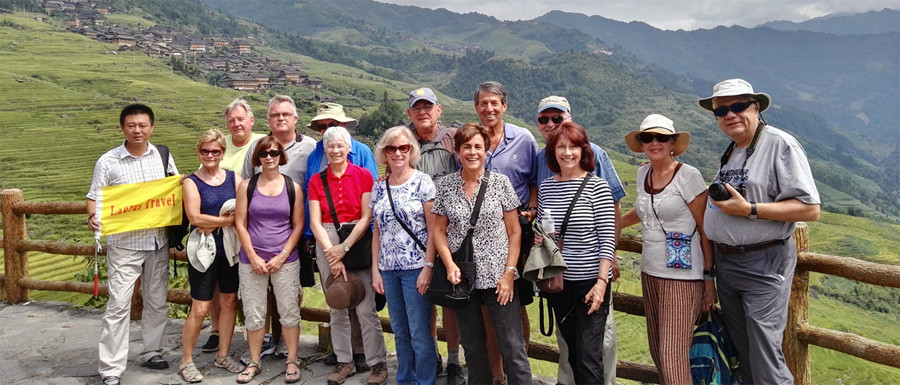
Shanghai – Huangshan (Yellow Mountain) – Qufu – Beijing – Xi’an –Guilin – Hong Kong
This fully guided China hiking tour is intended for travellers seeking a unique China experience that is both culturally rewarding and physically active. Due to the amount of walking and hiking involved, participants must be perfectly fit, free of any mobility issue. Hiking locations include Mt. Huangshan (Yellow Mountain), the Great Wall near Beijing, terraced rice fields outside Guilin and Victoria Peak in Hong Kong. Maximum age allowed for this tour is 75.
Important Features
- Small group size – (average 15, maximum 20)
- Expert guides handpicked by company owners
- Inter-city travel by high speed train except from Xi’an to Guilin
- No annoying forced shopping stops
- Quality meals at non-tourist restaurants
- Unlimited supply of bottled water during group activities
- Complimentary Wi-Fi in all hotels
- Great Wall visit at Mutianyu including cable car rides
Meal Code: B = breakfast / L = lunch / D = dinner
Day 1/Thu: Departing for Shanghai
Depart from a city of your choice and lose a day upon crossing the International Date Line.
Day 2/Fri: Arrival in Shanghai
Meet the driver on arrival for transfer to the hotel. You’ll have the balance of the day at leisure. The guide will get in touch with you tonight.
Day 3/Sat: Shanghai (B/L/D)
With a population of 24 million (2015), Shanghai is China’s biggest city, which delights the visitor with its futuristic skyline and historical landmarks. Rapid economic growth in the past 30 years has again turned Shanghai into a leading global city with significant influence in commerce, culture, finance, media, fashion, technology and transport.
Following tour orientation we visit Jade Buddha Temple located in an old neighbourhood, the famous waterfront promenade known as the Bund, and the Yu Garden in the old town centre. We wrap up the day with a drive through the glitzy financial district of Lujiazui on the opposite side of the Bund across Huangpu River.
Day 4/Sun: Shanghai (B)
Free day to explore on your own. We recommend Shanghai Museum and the Urban Planning Exhibition Center nearby. Shanghai Museum, a great place to explore on your own (audio guide available for a fee), is frequently cited by visitors as one of the best of its kind in China with a treasure trove collected from around the country.
Day 5/Mon: Shanghai – Huangshan (B/L)
After a leisurely breakfast we ride the high-speed train (2.5 hours) to the city of Huangshan, namesake of the famous mountain literally meaning Yellow Mountain. Known as ‘the loveliest mountain of China’, Huangshan is a mountain range composed of material that was uplifted from an ancient sea during the Mesozoic era, 100 million years ago. The mountains themselves were carved by glaciers during the Quaternary. Vegetation on the range is thickest below 1,100 metres (3,600 ft), with trees growing up to the timberline at 1,800 meters (5,900 ft). The area is well known for its scenery, sunsets, peculiarly shaped granite peaks, pine trees, hot springs, winter snow, and views of the clouds from above. Huangshan is a frequent subject of traditional Chinese paintings and literature, as well as modern photography.
Afternoon sightseeing at Hongcun, a key component of the UNESCO World Heritage Site collectively known as Ancient Villages in Southern Anhui. The traditional village represents a type of non-urban settlement that largely disappeared or was transformed during the last century. The street plan, architecture and decoration, and the integration of houses with comprehensive water systems are unique surviving examples.
Day 6/Tue: Huangshan (B/L/D)
After breakfast, we drive to the mountain and reach one of the peaks by cable car, thus beginning our full day exploration of the mountain. Located in the southern part of Anhui Province, Huangshan is a marvel: within an area of 154 square kilometers there are as many as 72 peaks, whose names indicate the shapes they resemble. In 1990, the UNESCO inscribed Huangshan a World Natural and Cultural Heritages Site. The beauty of Huangshan lies in its “four wonders”: pine trees with shapely foliage, peculiarly shaped rocks, sea of clouds, and hot springs.
Day 7/Wed: Huangshan – Qufu (B/L/D)
This morning we board the bullet train for Qufu (4 hours). Qufu is the hometown of Confucius (551-479 BC), who lived around the same time as Siddhartha Gautama (the Buddha) and Cyrus the Great of Persia. His teachings collectively known as Confucianism have played, and continue to play, a vital role in the evolution of the Chinese civilization.
This afternoon we tour the massive Confucius Temple which features a series of impressive gateways, clusters of twisted pines and cypresses, inscribed steles and tortoise tablets recording ancient events.
Day 8/Thu: Qufu (B/L)
We begin our sightseeing this morning at the mansion once inhabited by the sage’s descendants (now a museum). We then proceed to Confucius Forest – the last resting place of Confucius and cemetery for his descendants. The cemetery, the residence and the temple together form the UNESCO designated World Heritage Site in Qufu. If time allows, we will visit a village nearby.
Day 9/Fri: Qufu – Beijing (B/L)
We spend the morning exploring the small town on our own. After lunch we ride the bullet train to Beijing (80 minutes) and transfer to the hotel on arrival.
Capital of China, Beijing is a world-class cultural and educational centre with a population of 21.7 million (early 2017), ranking it China’s second biggest city behind Shanghai. Beijing is renowned for its opulent palaces, temples, and huge stone walls and gates – treasures that make it the most popular tourist city in China by the number of visitors it receives every year.
Beijing was already a strategically important city in northern China for centuries when Kublai Khan (1215-1294) decided to move his capital here from Karakorum in Mongolia. With the collapse of the vast Mongol empire in 1368, Beijing, known as Da Du or Grand Capital at the time, lost its status as the country’s capital but regained it in 1420 when the imperial court of the successive Ming Dynasty moved here from Nanjing. Beijing continued to serve as China’s capital after Manchu tribes dethroned the last emperor of the Ming Dynasty in 1644 and established the Great Qing Empire (Qing Dynasty), which lasted till 1912.
Afternoon sightseeing in Beijing takes in Lama Temple and Guozijian (imperial academy). Lama Temple, commonly known as Yonghe Temple among locals, was built in 1694 as residence of Prince Yong (Yinzhen), one of the sons of Emperor Kangxi. After Prince Yong ascended the throne as Emperor Yongzheng in 1722, half of his former residence was turned into a lamasery – a monastery for monks of Tibetan Buddhism. Guozijian was the highest institute of learning in China’s traditional educational system during the Yuan, Ming and Qing dynasties. Its main functions also included assisting the imperial court in administering national examinations.
Day 10/Sat: Sightseeing in Beijing (B/L/D)
Today’s itinerary begins with a visit to the Forbidden City, home to emperors from the Ming and Qing Dynasties. This UNESCO World Heritage Site, completed in 1420, consists of 980 buildings spread across 72 hectares. Next, visit Tian’anmen Square, one of the world’s largest public squares and a focal point of China’s modern history. In the afternoon, explore the Temple of Heaven, another UNESCO site, where emperors once conducted grand sacrifices. If you’re interested in shopping, the Hongqiao Pearl Market is nearby, renowned for its selection of pearls. End the day with a traditional dinner featuring Beijing’s famous roast duck.
Day 11/Sun: Great Wall Adventure (B/L)
After an early breakfast, embark on a full-day excursion to the Great Wall at Mutianyu, about 75 km northeast of Beijing. Stretching over 6,000 km, the Wall was built to defend against northern invaders, although it failed against Mongol forces during Kublai Khan’s reign. The sections of the Wall near Beijing are largely the result of reconstruction efforts from the Ming Dynasty.
Day 12/Mon: Beijing to Xi’an (B/L/D)
Begin your day with a visit to one of Beijing’s historic hutong neighborhoods, characterized by traditional courtyard houses. Next, explore the Summer Palace, a UNESCO site built as an imperial retreat. In the afternoon, board a high-speed train to Xi’an. The 4-hour journey offers scenic views of China’s rural countryside.
Day 13/Tue: Terracotta Army in Xi’an (B/L)
Xi’an, with its 3,000-year history, was the capital of several Chinese dynasties and home to the famous Terracotta Army. Your morning will be spent visiting this archaeological marvel, built to accompany China’s first emperor into the afterlife. Afterward, enjoy a stroll along Xi’an’s ancient city wall, one of the best-preserved in China.
Day 14/Wed: Xi’an to Guilin (B/L)
Start the day at the Shaanxi Provincial Museum, which traces the region’s history from ancient times to the Qing Dynasty. Later, visit Xi’an’s grand mosque and explore the adjacent Muslim bazaar. In the evening, fly to Guilin, known for its stunning natural beauty and karst landscapes.
Day 15/Thu: Li River Cruise (B/L)
Today, embark on a scenic five-hour cruise down the Li River, taking in breathtaking views of towering karst mountains and traditional Chinese villages. After lunch on board, disembark in Yangshuo and return to Guilin. The day wraps up with a visit to Fubo Hill, which offers panoramic views of the city.
Day 16/Fri: High-Speed Train to Hong Kong (B)
Spend a leisurely morning exploring Guilin before taking a high-speed train to Hong Kong. Hong Kong, a vibrant city known for its skyscrapers and natural harbors, was a British colony until 1997. Today, it operates under the “one country, two systems” model, retaining much of its autonomy.
Day 17/Sat: Exploring Hong Kong (B/L)
Your Hong Kong tour starts with a ferry ride across Victoria Harbour to Central, the city’s business district. Ascend Victoria Peak for stunning views of the city and surrounding islands. Stop briefly at Repulse Bay before retreating to a nice restaurant for our farewell luncheon. The afternoon is set aside for you to explore on your own. Your local guide will be glad to give you some advice on what to do.
Day 18/Sun: Departure from Hong Kong (B)
Your tour concludes today. You can take a taxi or the Airport Express Train to the airport for your return flight.

| City | Nights | Hotel | Hotel Category |
| Shanghai | 3 | Amara Signature Shanghai | 5 stars / luxury |
| Huangshan | 2 | Crowne Plaza Huangshan | 5 stars / luxury |
| Qufu | 2 | Shangri-la Qufu | 5 stars / luxury |
| Beijing | 3 | Sheraton Grand Dongcheng | 5 stars / luxury |
| Xi’an | 2 | Sheraton North City | 5 stars / luxury |
| Guilin | 2 | Sheraton Guilin | 5 stars / luxury |
| Hong Kong | 2 | Harbour Grand Kowloon | 5 stars / luxury |
Dates & Prices
discount available
Price based on double occupancy. See Terms & Conditions for cancellation penalty. Scroll down for what the tour price includes and excludes.
| Depart (Thu) | Return (Sun) | Land Only* CA$/US$ |
Single Supplement CA$/US$ |
| 2025 | |||
| 10-Apr | 27-Apr | $6,990/$4,990 | $2,310/$1,650 |
| 08-May | 25-May | $6,990/$4,990 | $2,310/$1,650 |
| 11-Sep | 28-Sep | $6,990/$4,990 | $2,310/$1,650 |
| 09-Oct | 26-Oct | $6,990/$4,990 | $2,310/$1,650 |
| 23-Oct | 09-Nov | $6,990/$4,9900 | $2,310/$1,650 |
* Land Only price does NOT include international airfare. Please contact us for a fare quote.
|
What the tour price includes:
|
What the tour price excludes:
See Terms & Conditions for more information. |

